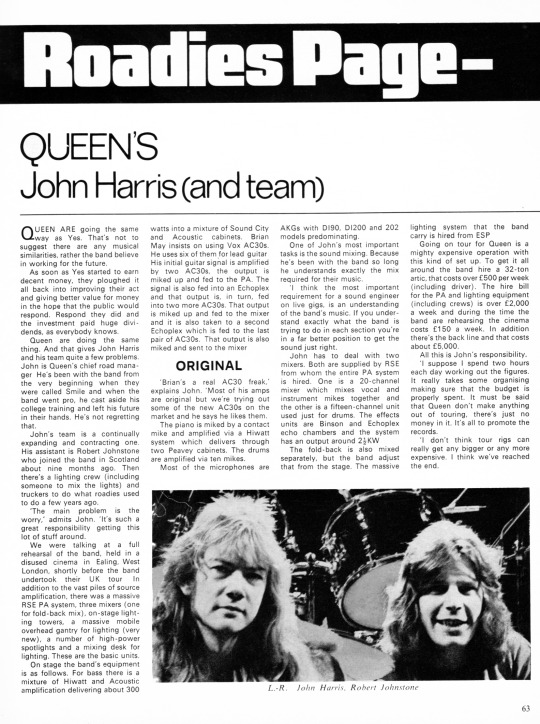#Queen just kept expanding their rigs against all odds!! it just kept growing and never stopped!
Text

Queen's chief road manager & FOH sound mixer John Harris's interview in the Roadies Page -segment of Beat Instrumental, December 1974 issue (article scanned & edited by me)
This interview with John Harris in 1974 gives very fascinating insights into the technical side of touring with Queen, including managing & transportation of the equipment, and balancing the books!
Beat Instrumental was a UK monthly pop and rock magazine aimed at musicians emphasising instruments, production and equipment.

Full transcript under the cut:
Roadies Page-
QUEEN'S John Harris (and team)
QUEEN ARE going the same way as Yes. That's not to suggest there are any musical similarities, rather the band believe in working for the future.
As soon as Yes started to earn decent money, they ploughed it all back into improving their act and giving better value for money in the hope that the public would respond. Respond they did and the investment paid huge dividends, as everybody knows.
Queen are doing the same thing. And that gives John Harris and his team quite a few problems. John is Queen's chief road manager. He's been with the band from the very beginning when they were called Smile and when the band went pro, he cast aside his college training and left his future in their hands. He's not regretting that.
John's team is a continually expanding and contracting one. His assistant is Robert Johnstone who joined the band in Scotland about nine months ago. Then there's a lighting crew (including someone to mix the lights) and truckers to do what roadies used to do a few years ago.
'The main problem is the worry,' admits John. 'It's such a great responsibility getting this lot of stuff around.’
We were talking at a full rehearsal of the band, held in a disused cinema in Ealing, West London, shortly before the band undertook their UK tour. In addition to the vast piles of source amplification, there was a massive RSE PA system, three mixers (one for fold-back mix), on-stage lighting towers, a massive mobile overhead gantry for lighting (very new), a number of high-power spotlights and a mixing desk for lighting. These are the basic units.
On stage the band's equipment is as follows. For bass there is a mixture of Hiwatt and Acoustic amplification delivering about 300 watts into a mixture of Sound City and Acoustic cabinets. Brian May insists on using Vox AC30s. He uses six of them for lead guitar. His initial guitar signal is amplified by two AC30s, the output is miked up and fed to the PA. The signal is also fed into an Echoplex and that output is, in turn, fed into two more AC30s. That output is miked up and fed to the mixer and it is also taken to a second Echoplex which is fed to the last pair of AC30s. That output is also miked and sent to the mixer.
ORIGINAL
'Brian's a real AC30 freak.' explains John. 'Most of his amps are original but we're trying out some of the new AC30s on the market and he says he likes them.' The piano is miked by a contact mike and amplified via a Hiwatt system which delivers through two Peavey cabinets. The drums are amplified via ten mikes.
Most of the microphones are AKGs with D190, D1200 and 202 models predominating.
One of John's most important tasks is the sound mixing. Because he's been with the band so long he understands exactly the mix required for their music.
'I think the most important requirement for a sound engineer on live gigs, is an understanding of the band's music. If you understand exactly what the band is trying to do in each section you're in a far better position to get the sound just right.’
John has to deal with two mixers. Both are supplied by RSE from whom the entire PA system is hired. One is a 20-channel mixer which mixes vocal and instrument mikes together and the other is a fifteen-channel unit used just for drums. The effects units are Binson and Echoplex echo chambers and the system has an output around 23KW.
The fold-back is also mixed separately, but the band adjust that from the stage. The massive lighting system that the band carry is hired from ESP.
Going on tour for Queen is a mighty expensive operation with this kind of set up. To get it all around the band hire a 32-ton artic, that costs over £500 per week (including driver). The hire bill for the PA and lighting equipment (including crews) is over £2,000 a week and during the time the band are rehearsing the cinema costs £150 a week. In addition there's the back line and that costs about £5,000.
All this is John's responsibility.
'I suppose I spend two hours each day working out the figures.
It really takes some organising making sure that the budget is properly spent. It must be said that Queen don't make anything out of touring, there's just no money in it. It's all to promote the records.
'I don't think tour rigs can really get any bigger or any more expensive. I think we've reached the end.’
#'I don't think tour rigs can really get any bigger or any more expensive. I think we've reached the end' - in hindsight this is so endearing#Queen just kept expanding their rigs against all odds!! it just kept growing and never stopped!#queen#queen band#john harris#brian may#robert johnson#classic rock#research#my scans#my stuff#my posts
43 notes
·
View notes